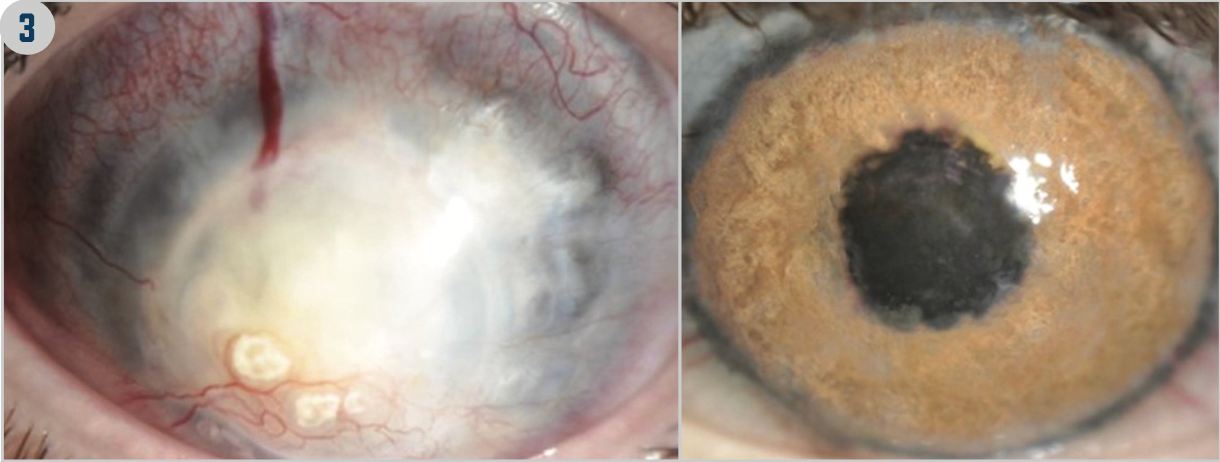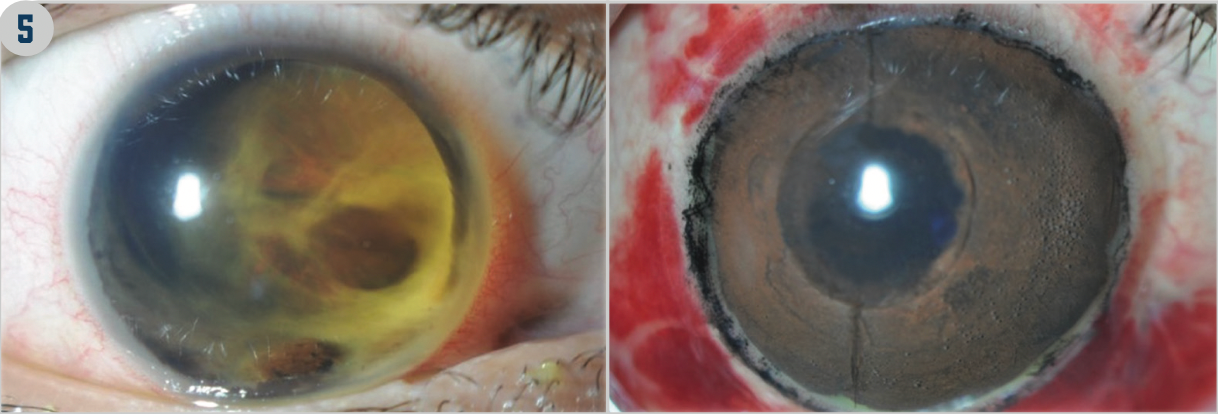Publication
Article
Digital Edition
Cosmetic surgery of the cornea: A new type of surgery
Author(s):
Keratopigmentation technique offers therapeutic and cosmetic applications.
(Image Credit: AdobeStock/CСKing)

Over the past 10 years, an increasing number of studies have been conducted on the topic of keratopigmentation, that is, the induced cosmetic pigmentation change in the cornea.
This cosmetic change can be done for therapeutic purposes (eg, for corneal leukomas and blind and disfigured eyes, as well as cases with traumatic aniridia or other problems that affect the eye’s quality of vision).
The topic has been extensively studied and covered in a series of papers that have demonstrated that such techniques are effective, feasible, and very useful for patients.1-16
Following this, the purely cosmetic application of this technique has offered the possibility to change the apparent color of the eye on a voluntary basis. This is purely an aesthetic application that has been obviously disruptive and controversial. My colleagues and I first described this technique,7 and it has been practiced in Europe by a few surgeons on a continual but selective basis. The biotolerance and local toxicity of the pigments used in keratopigmentation have been the subject of extensive experimental studies.2,6,8 In Figure 1, we display the instruments used in the modern keratopigmentation surgical technique.


FIGURE 1. Instruments Used in Keratopigmentation
FIGURE 2. Femtosecond-Assisted Intrastromal Keratopigmentation
FIGURE 3. Superficial Keratopigmentation (Images courtesy of Jorge L. Alió, MD, PhD, FEBOphth)

Therapeutic keratopigmentation is indeed a new and relevant type of corneal surgery; however, it is still not in general use, essentially because of the insufficient development of pigments specifically for corneal use. Patients with disfigured corneas and blind eyes, and patients who prefer not to go through the trauma associated with evisceration and enucleation and their potential complications, find this new type of surgery can prove to be a very valuable alternative that can successfully restore their appearance in a less invasive manner.1,10
The pigment may be placed inside the corneal stroma when the superficial cornea is transparent (intrastromal keratopigmentation); (Figure 2). With totally opaque corneas, the technique should be performed by applying the pigment on the corneal surface (superficialkeratopigmentation)9,11; (Figure 3), either manually or using an automatic device (Figure 4). In superficial keratopigmentation, the pigment is injected into the superficial corneal stroma up to the level of 140 mm, after denuding the corneal epithelium (Figure 3).
Superficial leucomas are treated with superficial techniques, whereas deep opacities, aniridias, and other problems that happen in a patient’s eye are better treated by intralamellar techniques.4,5 Surgical instruments and techniques have also been described in detail in other publications.15 (Figures 1 and 4).
When the superficial corneal stroma is transparent, the intrastromal pigmentation technique can be better used. For this purpose, corneal stromal tunnels are created, assisted by femtosecond laser at the adequate corneal depth,4,5 which also creates a dissection to simulate the pupil at an adequate diameter (Figure 2).
FIGURE 4. Superficial Automated Keratopigmentation Device

Such corneal tunnels may also be created manually using adequately designed instruments (Figures 1 and 2).
The pigment is matched to the color of the contralateral normal eye, whereas the pupil is simulated with black pigment (Figure 5).
The main limitation of this technique is the availability of pigments, which are, as of the writing of this article, limited to a few colors and labeled for corneal use with the CE mark. The use of dermatological pigments probably could be acceptable, but the lack of negative effects has not yet been demonstrated on the normal or diseased cornea, as the pigments are made of compounds that are often reactive when in contact with light; thus, oxidation may occur. This can lead to a change in the color over time and might make outcomes of this surgery unpredictable.
Frequently, severely compromised and blind eyes are associated with other disfiguring features such as squint and ptosis, which can also be successfully corrected at the same time as the keratopigmentation procedure is performed. A high level of patient satisfaction has been reported with the use of such combined surgical techniques12 (Figure 6).

FIGURE 5. Manual Intrastromal Keratopigmentation and Pupil Simulation With Superficial Automated Keratopigmentation. Total corneal leucoma (left) and result after treatment with femtosecond- assisted intrastromal keratopigmentation and superficial automated keratopigmentation for the pupil (right).
FIGURE 6. Keratopigmentation With Strabismus Surgery. Preoperative appearance before keratopigmentation and squint surgery (top) and postoperative result (right). (Images courtesy of Jorge L. Alió, MD, PhD, FEBOphth)

Functional disabilities are caused by iris problems such as aniridia, iris atrophy and iris colobomas.3-5 Some of these cases, whichither have no solution or require extensive and invasive surgeries, may be approached today with intrastromal keratopigmentation. Even intractable diplopias can be solved with keratopigmentation creating a central scotoma through the creation of a simulated pupil of adequate diameter.15,16
Controversial topic
The purely cosmetic use of keratopigmentation is disruptive and controversial because of the voluntary change of color of the eye that intrinsically has this problem. The procedure is elective, can be performed inadequately, and can lead to complications in normal eyes. With respect to this fact, findings from a recent study13 demonstrated that keratopigmentation is, undoubtedly, the best option available for those individuals who wish to change the apparent color of the eye on a voluntary basis. It demonstrates superior safety to and better outcomes than the alternative approaches using iris color prosthesis or laser iris depigmentation procedures, which are affected by myriad severe complications that can lead to severe visual loss and even blindness.14 In particular, the use of prosthetic colored irises should be considered today as a medical malpractice procedure because of the proven severe comorbidities that have been demonstrated to be induced by their implantation in the medium and long terms.
Emerging surgical technique
With this in mind, it should be considered that this emerging surgical technique of keratopigmentation has been refined with the modern development of specific surgical instruments. These include femtosecond lasers and the modern development of pigments. However, the corneal pigments used are considered underdeveloped owing to the main limitation of this technique to be used in general.
Thus, this technique is open to future developments that will be extremely attractive for ophthalmologists, corneal specialists, and cosmetic surgeons. It will also be attractive for patients affected by morbidities that affect the cosmetics of their eyes due to disfiguring corneal leukomas. The procedure will also appeal to patients who desire to change their appearance through the color of their eyes, which should be done for good reason and with appropriate selection by their surgeons.
A new corneal surgical perspective is now available with a good level of published evidence in support. I envision a promising future that will follow this group of new surgical techniques. This topic will probably progress immensely in the coming years along with the increase in clinician experience and the development of more appropriate, specific, and diverse corneal pigments.
Jorge L. Alió, MD, PhD, FEBOphth
E: jlalio@vissum.com
Alió is professor and chairman of ophthalmology at Miguel Hernández University, and founder of Vissum Miranza in Alicante, Spain.
References:
1. Alio JL, Sirerol B, Walewska-Szafran A, Miranda M. Corneal tattooing (keratopigmentation) with new mineral micronised pigments to restore cosmetic appearance in severely impaired eyes. Br J Ophthalmol. 2010;94(2):245-249. doi:10.1136/bjo.2008.149435
2. Sirerol B, Walewska-Szafran A, Alio JL, Klonowski P, Rodriguez AE. Tolerance and biocompatibility of micronized black pigment for keratopigmentation simulated pupil reconstruction. Cornea. 2011;30(3):344-350. doi:10.1097/ICO.0b013e3181eae251
3. Alio JL, Rodriguez AE, Toffaha BT. Keratopigmentation (corneal tattooing) for the management of visual disabilities of the eye related to iris defects. Br J Ophthalmol. 2011;95(10):1397-1401. doi:10.1136/bjophthalmol-2011-300170
4. Alió JL, Rodriguez AE, Toffaha BT, Piñero DP, Moreno LJ. Femtosecond-assisted keratopigmentation for functional and cosmetic restoration in essential iris atrophy. J Cataract Refract Surg. 2011;37(10):1744-1747. doi:10.1016/j.jcrs.2011.08.003
5. Alio JL, Rodriguez AE, Toffaha BT, El Aswad A. Femtosecond-assisted keratopigmentation double tunnel technique in the management of a case of Urrets-Zavalia syndrome. Cornea. 2012;31(9):1071-1074. doi:10.1097/ICO.0b013e318243f6b1
6. Amesty MA, Alio JL, Rodriguez AE. Corneal tolerance to micronised mineral pigments for keratopigmentation. Br J Ophthalmol. 2014;98(12):1756-1760. doi:10.1136/bjophthalmol-2014-305611
7. Alió JL, Rodriguez AE, El Bahrawy M, Angelov A, Zein G. Keratopigmentation to change the apparent color of the human eye: a novel indication for corneal tattooing. Cornea. 2016;35(4):431-437. doi:10.1097/ICO.0000000000000745
8. Amesty MA, Rodriguez AE, Hernández E, De Miguel MP, Alio JL. Tolerance of micronized mineral pigments for intrastromal keratopigmentation: a histopathology and immunopathology experimental study. Cornea. 2016;35(9):1199-1205. doi:10.1097/ICO.0000000000000900
9. Rodriguez AE, Amesty MA, El Bahrawy M, Rey S, Alio Del Barrio J, Alio JL. Superficial automated keratopigmentation for iris and pupil simulation using micronized mineral pigments and a new puncturing device: experimental study. Cornea. 2017;36(9):1069-1075. doi:10.1097/ICO.0000000000001249
10. Alio JL, Al-Shymali O, Amesty MA, Rodriguez AE. Keratopigmentation with micronised mineral pigments: complications and outcomes in a series of 234 eyes. Br J Ophthalmol. 2018;102(6):742-747. doi:10.1136/bjophthalmol-2017-310591
11. Al-Shymali O, Rodriguez AE, Amesty MA, Alio JL. Superficial keratopigmentation: an alternative solution for patients with cosmetically or functionally impaired eyes. Cornea. 2019;38(1):54-61. doi:10.1097/ICO.0000000000001753
12. Balgos JD, Amesty MA, Rodriguez AE, Al-Shymali O, Abumustafa S, Alio JL. Keratopigmentation combined with strabismus surgery to restore cosmesis in eyes with disabling corneal scarring and squint. Br J Ophthalmol. 2020;104(6):785-789. doi:10.1136/bjophthalmol-2019-314539
13. D’Oria F, Alio JL, Rodriguez AE, Amesty MA, Abu-Mustafa SK. Cosmetic keratopigmentation in sighted eyes: medium- and long-term clinical evaluation. Cornea. 2021;40(3):327-333. doi:10.1097/ICO.0000000000002417
14. D’Oria F, Abu-Mustafa SK, Alio JL. Cosmetic change of the apparent color of the eye: a review on surgical alternatives, outcomes and complications. Ophthalmol Ther. 2022;11(2):465-477. doi:10.1007/s40123-022-00458-2
15. Alio JL, Amesty MA, Rodriguez A, El Bahrawy M, eds. Text and Atlas on Corneal Pigmentation. 1st ed. Jaypee Brothers Medical Publishers (P) Ltd; 2015.
16. Laria C, Alió JL, Piñero DN. Intrastromal corneal tattooing as treatment in a case of intractable strabismic diplopia (double binocular vision). Binocul Vis Strabismus Q. 2010;25(4):238-242.

Newsletter
Don’t miss out—get Ophthalmology Times updates on the latest clinical advancements and expert interviews, straight to your inbox.




